Hello Friends!
I’m Fionna, a product manager, YouTuber and late-night FM DJ.
Every Sunday I share a story on what inspires me to be creative. I’m fascinated by design, technology, people, languages, and the idea that I can use what I learn to reinvent myself.
You will find that I express myself through different languages, witty mEmeS and impeccable formatting. Want more content like this in your inbox?
Let this be our creative outlet.
Twitter | YouTube | Instagram | LinkedIn | Newsletter | Spotify | Buy me a 🍍
Almost as a tradition. Every time I go back to Toronto, I must visit the University of Toronto Campus. Namely the faculty of Engineering buildings that I spent 4 years in. Too many (painful AER, ESC, BME 😵… ) memories, but after 2020, everything turned into a blessing.
I feel fortunate that I got to attend classes in person, nerd out in the libraries, pull all-nighters in the common room, and receive my iron ring in what’s known as the Ritual of The Calling of an Engineer✨.
Note: Notice how I (probably most engineers) care more about the iron ring ceremony than convocation? Convocation is for parents and photo-ops, the ring is the real deal. 😍
So during my visit, I walk around the front campus, which is under *major* renovation by the way, and past Con Hall. I arrive at the way-too-familiar engineering complex.
I walk into Sandford Fleming, down the hallway to Galbraith, then out to St. George Street, jay-walk to Bahen (what else do you do, wait for the light? 🤷♀️). Go up to the second floor, turn right, and look into the EngSci common room that I spent half of my waking hours of college there… yup, still looks the same.
Then I keep walking down the hallway to the EngSci Office. Then, this very colorful poster caught my eye.
I stopped abruptly.
Took a few steps in to get a closer look.
This is it!
After graduating, I had numerous chats with interns, new grads and mentees about my career journey and how I got into product management with a biomed degree. Every time I tell them, “I studied biomedical engineering at UofT, which is nothing related to what I do now 😅”, I think to myself, “If so then… what did I learn from school? Did engineering help me get to where I am at all? It should have… right? But how?”
Yes, and yes.
And this poster is the answer. Well, one aspect of it.
Allow me to walk you through this 🌈 rainbow of “Graduate Attributes” one by one, and see how it tallies up with what I think I should’ve learned vs. what I actually learned… and uncover that ONE thing I took away from all of this education.
🛑 Disclaimer:
The following contains vastly unnecessary nerdy Canadian engineering references and satire that’s probably uncalled for. If you are a person not familiar with the matter, please meet the mythical creature that is an UofT engineer👷♀️👷👷♂️), and kindly consider preparing yourself before proceeding. There is going to be a lot of purple 🟣, don’t say I didn’t warn ya! 😉
Lots of ground to cover. Let’s carry on.
1. Knowledge base for engineering
Competence in Math: Yes, after moving to the US, I can use math to convert fahrenheit to degrees, which is very helpful in the “how’s the weather” conversations with Americans. Jokes aside, basic math is definitely required, but advanced calculus is never used. However, knowing statistics and the p-value is very helpful in understanding experimentation. Based on my observation in these meetings, nobody asked “what is the p-value”, so I assumed we all took stats. 🤓
Understand engineering fundamentals: when in doubt, always refer back to the First Principles.
First Principles actually came up in my first few 1:1s with my manager. I think he would’ve thought that I’m a fraud if I didn’t know it... “Do you really have an engineering degree if you don’t know First Principles?” 😬
Which then gave me permission to ask a lot of why’s (known as socratic questioning) with my newbie card. Such as “Why is this built this way?” or “Why do users need this?”.
Possess specialized knowledge: If fundamentals covered breadth, then specialized knowledge gave me depth. I know how to pipette liquids, operate a centrifuge and read DNA. Best part, how to write 5 pages of “possible sources of error” during the 3 hours of waiting in the lab. Needless to say, this taught me to be patient, detail-oriented, reflective, and multi-task-able. ✅
2. Problem Analysis
Characterize an engineering problem: The Quebec bridge was collapsed in 1907 because the calculations were not properly checked.
Formulate a solution: Create a checklist, enforce safety protocols, appoint a new chief engineer, and rebuild in 9 years.
Formulate and interpret a model: An appropriate process or a combination of processes needs to be in place for the problem at hand. For example, in developing a software, is it best to use waterfall, agile or iterative, or a combination? Also, one should always double, triple and quadruple check, especially when a small error can literally cost lives or taxpayers a few hundred M’s. Redundancy is our friend.
Execute solution: Besides rebuilding the bridge with a robust process, moldthe fallen iron debris into rings, distribute to engineering graduates and command them to wear it on the pinky of their dominant hands. So when they sign off on a calculation, they leave a dent on the page and remember to never make the same mistakes again. 🙌
3. Investigation
Define a problem: Use first principles thinking to remove assumptions and only focus on the facts that make up the problem - “I don’t have time to write this newsletter post.” No, I have far more time than I think I have, especially in lockdown. Saying that I don’t have time to write is just a convenient excuse to spend the time on other things. Using first principles thinking means asking how much time I can spend on writing, and we all know it’s more than what I’d admit. So knowing that I have the time required, I need to reframe the problem to find why I’m choosing others over writing, what’s blocking me from writing this very post, and what I can do to overcome that.
Turned out, I started off this post too ambitiously. Wanting to elaborate and tell a story for all 12 attributes, and incorporate a right balance of satire. The first 2 attributes took me a while to get it presentable and the thought of writing 10 more just seemed daunting. Also, I needed to familiarize myself with these engineering lingo again and think of school and work scenarios to use as examples. So I pushed it off for days then weeks and substituted my instant gratification from publishing a post to publishing vlogs. #MetaToTheMax
Devise and execute a plan to solve a problem: This problem was blocking me from writing anything new. So I thought of a few plans.
Do a pass on the remaining attributes and jot down the first thing that came to mind - This breaks down the daunting task into smaller pieces and gets my rusty engineering brain spinning throughout the day.
Do something that relates to this - Luckily I was prepping for a Product School talk on how I got into PM with a biomed degree, so I double dipped on the preparations there 1️⃣🪨.2️⃣🦜.
Find and schedule recurring time to write - I found night time to be the most optimal for writing. Dim the lights, play some lofi hip hop, and volume up for the keyboard ASMR.
Choose a few attributes to focus on and “mEh” the rest - Not all 12 attributes were made equal and some had a stronger impact on me than others. I don’t have to kill myself by coming up with a compelling story for each. Hey, this is my newsletter. I set the rules and I can have fun with it if I want to! 😎 #dontunsubplz
Get help - I got through my first draft and asked my friends to proof read and give me feedback. I’m looking at them side by side right now to see how I can make this post more enjoyable (or convoluted 🤯).
Use critical analysis to reach valid conclusions supported by the results of the plan: Let’s start with the results. If you’re reading this, then my problem has been solved, so… ✅ Now let’s analyze my plans critically to see if they would lead to the same result:
We can probably all attest to it, but Psychology Today puts it in writing, when facing a big challenge, “breaking down a large project or situation into small, reasonable tasks that bit by bit add up to a brilliant whole is a key strategy.”
I just did the same work but wrapped in a different project.
From saying that I don’t have time to blocking time in my calendar. The word count should be guaranteed to increase (quality is however questionable).
I gave myself permission to opt out writing about attributes that I don’t resonate with, and focus on the ones that I have strong opinions on.
Their feedback unveiled where needed more work, and aspects of the attributes that I missed. Having had other eyes on the draft, and even some “I enjoyed reading👌”, this gave me the confidence to finally publish it for you to read!
4. Design
Frame a complex, open-ended problem in engineering terms: Categorize the problem in an engineering discipline, and use respective engineering terms to concisely describe it so your fellow engineers can understand, and your dinner guests are in awe of your sophisticated vocabulary.
Generate a diverse set of candidate engineering design solutions: It’s important to have options, so I can compare the pros and cons for the best bang for my buck. I find it helpful to use the SCAMPER technique to get Option B, Option ZZ, and Option YYZ.
Select candidate engineering design solutions for further development: When selecting the final candidates, a rigorous evaluation framework needs to be in place. RICE is great for product decisions, not only handy for “the interview”, but also useful in actual roadmap planning. Though there are definitely more than 4 factors to consider IRL.
Advance an engineering design to a defined end state: Starting with a “back-of-the-napkin” drawing or otherwise lovely named, “PM art”, I then bring that to a designer with actual design training, to make it look more legit and c~o~h~e~r~e~n~t. #nooffense #iloveworkingwithdesigners
5. Use of Engineering Tools
Use fundamental modern techniques, resources and engineering tools: Google
Use discipline-specific techniques, resources and engineering tools: Google first, then PubMed
Recognize limitations of the tools used: Always remember to factor in the uncertainty of the measuring apparatus such as rulers and weights, and carry these ±0.05𝑐𝑚 in all later calculations. I also learned that there will be bias all over the internet and in prestigious scholarly journals (cough PubMed cough). So it’s critical to seek out different perspectives before forming my own opinion.
6. Individual & Teams Work
Establish and monitor team organizational structure: An org chart that details everyone’s responsibilities is immensely helpful for not only the team, but new members and partner teams too. I highly recommend pinning the chart and update it whenever there’s a change. In terms of monitoring the org structure, I think it’s useful to be in the know when you suddenly becomes an individual contributor from a lead. 🤔 #leetcodetime
Promote team effectiveness through individual action: Good things are meant to be shared. I recommend everyone to use Notion whenever I get the chance.
Be successful in a team-based project: I learned that team success comes before individual success. If the team enjoyed working together, had a good time, then everyone already won. In order to get there, I need to first do my part, empathize with others, and don’t throw anyone under the bus - It’s not worth it, can’t be undone, and looks terrible on you. 😶
7. Communication Skills
Identify and credibly communicate engineering knowledge: When I say “hey” you say “ho”. Hey-Ho! Hey-Ho! (You need to watch this).
Use different modes of communication: println(“h311o w0r1d”);
Some times it’s not what you say but how you say it. I think it’s critical to get to know your teammate’s preferred communication style, and leverage that to build a better relationship and get things done faster. In most cases, people tend to respond to an ask better if I ask them 1:1, versus tagging them in a post (a little passive aggressive might I add). If it’s an ask for an important person, I would make sure to craft a cohesive but concise story to emphasize my point because I know they didn’t read my previous 10 messages.Develop communication through an iterative process: read → think → write → think → speak → listen → think → read → think → write → think → trying to remember what you read first.
8. Professionalism
Describe engineering roles in a broader context (pertaining to the environment, health, safety and public welfare): We are here to solve problems and leave the world a better place than we found it.
Recognize the impact of engineering within global society (the broader public interest): Developing a COVID-19 vaccine within a year of the outbreak is engineering on steroids. I am floored by the velocity of R&D and accuracy - humanity is actually being saved by this vaccine. Plus, the work that Engineer Without Borders is doing has always been epic!
Behave in a professional manner: Absolutely. Hold the door open for the person behind you, stop the traffic for passing bears, and never, EVER, leave the house without the ring.
9. Impact of Engineering on Society & Environment
Understand relationships among technology and the social, cultural, economic and environmental conditions of society— both locally and globally, and in the short- and long-term: Next time when you are offered a beef burger and an impossible burger, understand the impact of your actions on the environment.
Identify and choose alternative ways to mitigate or prevent adverse social, environmental, health and safety impacts: Wear a mask.
Demonstrate awareness of legal issues relevant to an engineering activity: Vote.
10. Ethics & Equity
Recognize ethical and equity-based dilemmas: Should I be happy that it’s summer weather in April?
Apply the Code of Ethics and equity principles: When I find an one cent coin, I should not spend it but turn it to a nearby museum.
Act ethically and demonstrate individual accountability: If anything, don’t jinx other people’s PR (push request).
11. Economics & Project Management
Estimate the life-cycle economic and financial costs and benefits for relevant engineering activities: Will investing in electric cars save us more money in the long run? Yes.
Evaluate the economic and financial performance of an engineering activity and compare alternative proposals on the basis of these measures: S3XY electric cars or a roaring Porsche 911 GT3 RS vrooming by. I honestly can’t decide.
Read and understand financial statements for engineering activities: Yes. Expensive.
Plan and manage engineering activities to be within time and budget constraints: Yes. But maybe just a little bit over.
12. Lifelong Learning
Independently summarize, analyze, synthesize and evaluate information from a wide variety of sources: Being able to read a book or article and extract the main arguments succinctly is a must-have skill. Especially when I’m taking notes in a spec review where I have to jot down people’s feedback, changes I need to make, telemetry that I need to collect, and people I need to follow up with, whilst synthesizing everything into a formatted summary 30 mins (max) after the meeting. Yea, good luck with that.
Develop a strategy to identify and address gaps in knowledge: I will never know everything and that’s not my goal. The goal is to know a little bit more than the person who I was yesterday. The best strategy I learned is to be curious and ask thoughtful questions along the way.

Looking at this poster was like looking at a mirror. This is how I feel about engineering, and what it has taught me.
If you have this burning why in your chest, that you want to figure out how things work, how you can build something from scratch, and this undying curiosity to get to know what you don’t know. Engineering might just be for you!
Now the final takeaway from all of this…
If the world taught me to stay curious. Then engineering taught me how to make sense of this curiosity and teach it to others.
(With a sprinkle of trolling threw into the mix ofc #BFCWhereUAt)
Disclaimer: I hope you didn’t take this post completely seriously. There are definitely some heart-felt takeaways, but if you know you know… 😉
More University of Toronto Engineering Things
Professor Collins on CIV102. One of the most respected professors by my class, and probably all students of CIV102 in the last few decades. His lecture on "In search of elegance”.
Thank yous ❤️
Lastly, I’d like to thank my friends who proof-read this draft and gave me valuable feedback! This post has been 1.5 months in the works (!!!) and I’m 67% satisfactory of the turnout - well, lifelong learning right 😉 *virtual hugs*
If you found this amusing in anyway, I’d love it if you could share it with a friend or on social media - this will help my newsletter a lot :)
You might like these
What’s coming to your inbox
My new desk setup: the what and why
Adulting as a Product Manager
Where to find me
👩💻 Twitter: @fionnagan
👩🍳 YouTube: Fionna Gan
👩🎤 Instagram: @fionna.gan
👩🎓 LinkedIn: Fionna Gan
🤹♀️ Newsletter: The Creative Outlet
👩🚀 Voice: The Creative Outlet
🏡 Clubhouse: @fionnag








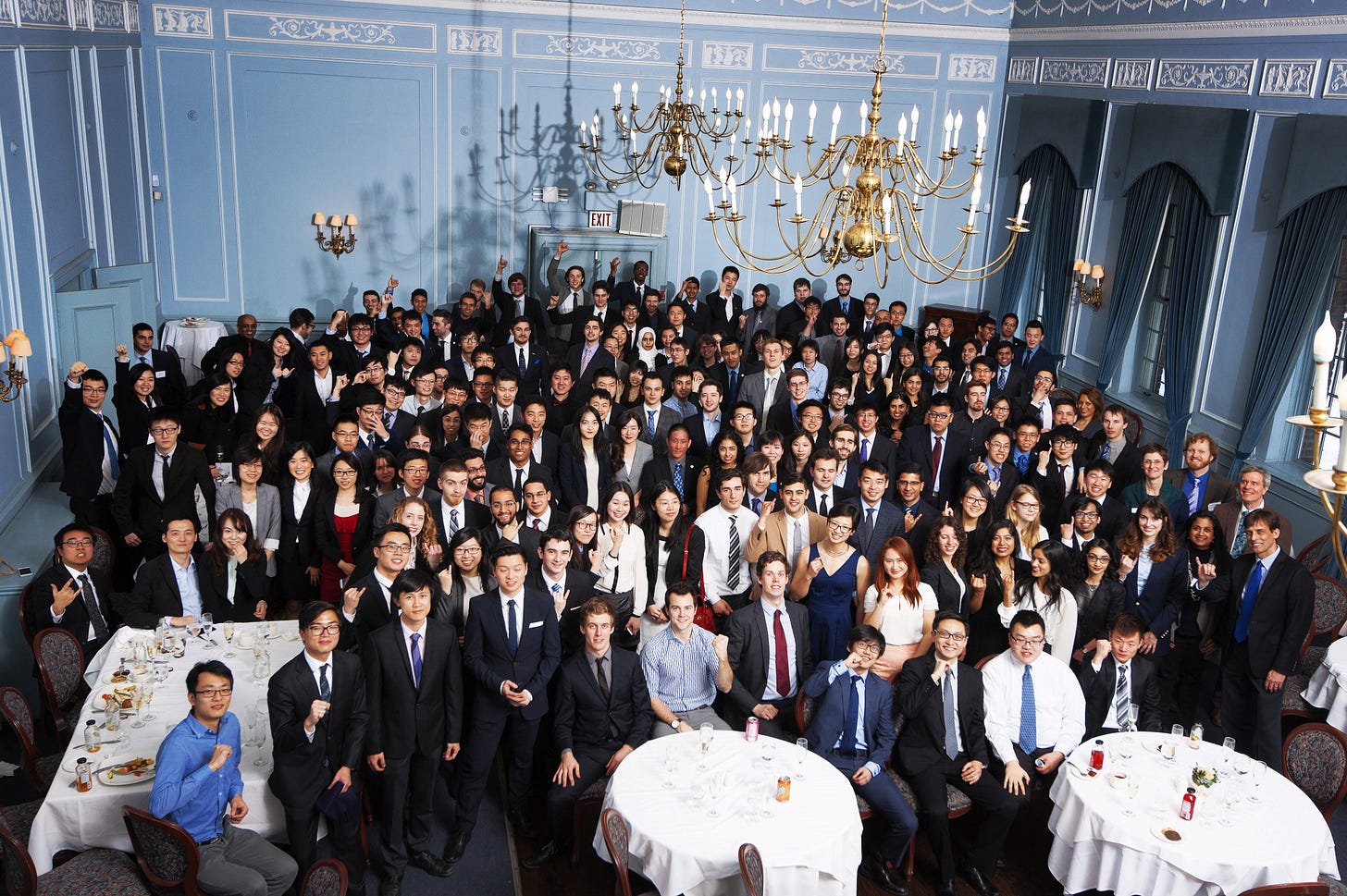
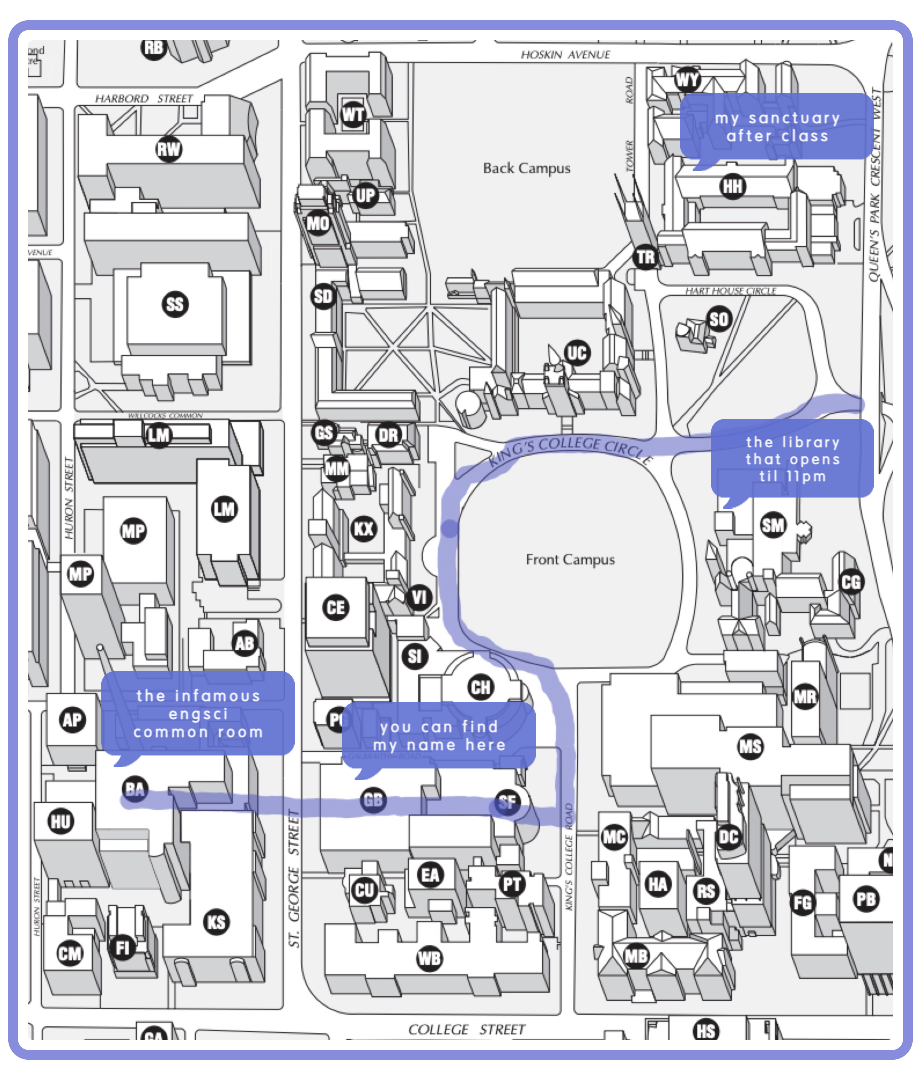


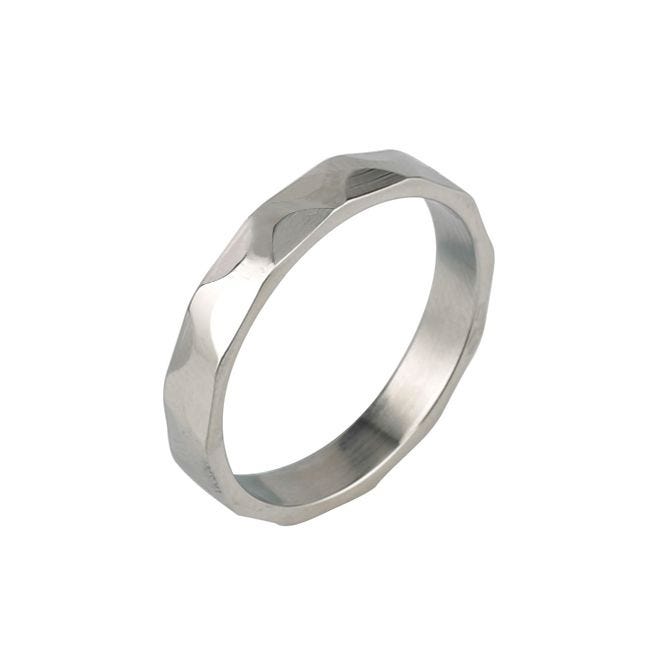
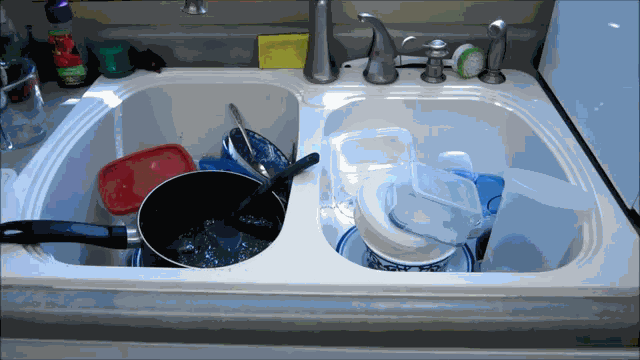
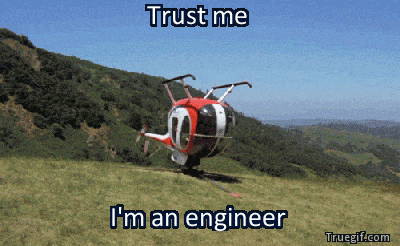








Share this post